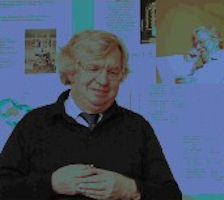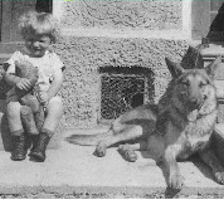 |
STAGES PER STUDENTI DI SCUOLA SECONDARIA STAGES INVERNALI 2009 |
 |
 |
PAUL KIENLE
|
|
As you can see in the two photos, shown above, I grew up on a farm in a small Suebian village, Bihlafingen, located in the upper Danube valley in Germany and enjoy now research as Professor Emeritus of the Technische Universität München. Between the two photos is a huge time span of nearly 75 years with vast experiences. I went to a single class public school in Bihlafingen, and with nine years old I started commuting with a bike during war time to the 10 km distant small town Laupheim, for getting higher education for six years. Then I had to go into a boarding school of the Christian Brothers in Illertissen, where I graduated in 1949 and started studying Technical Physics at the Technische Hochschule (TH) München (now Technische Universität (TU) München). For my Diploma Thesis I developed localizing Geiger-Müller detectors and used them for measuring radiation fields for my Dr. Thesis which I submitted in 1957. Then I spent 1 1/2 years as postdoctoral fellow at Brookhaven National Laboratory, Upton, NY, where I got first an education in Health Physics to build up a Radiation Safety Group in 1958 at the new Research Reactor FRM in Garching near Munich,. This was also the time when my study colleague Rudolf Mössbauer discovered recoil free resonance absorption of gamma rays, nowadays called the "Mössbauer Effect", for which he got in 1961 the Nobel Prize. I started to work on the application of the Mössbauer Effect in nuclear structure, chemical bonds, and magnetism, which lead in 1962 to what we call "Habilitation", the highest academic degree required for getting a teaching permit at a German university. Actually I was offered shortly afterwards a chair as a Professor for Radiation and Nuclear Physics at the Technische Hochschule Darmstadt. During three years I built up a Mössbauer Effect research group in Darmstadt, but in 1965 I accepted an offer of a Chair for Experimental Physics at the Physik-Department of the TH München, joining my famous teacher Heinz Maier-Leibnitz and my student friend Rudolf Mössbauer. Together with Professor Mayer-Berkhout from the Ludwig-Maximilians-Universität München I was responsible for the construction of an Accelerator Laboratory of both Munich universities, which started operation in 1970 in Garching. My research interest focused now on heavy ion physics and on the development of accelerator facilities for this new field of research. In 1984 I accepted an offer to become the Scientific and Technical Director of the GSI Darmstadt and led the design and construction of a heavy ion synchrotron and Experimental Storage Ring (ESR) which took up successful operation in 1990. Two years later in 1992 I returned to the TU München and continued research in medium energy heavy ion physics at the unique research facilities of the GSI in Darmstadt. In 1992 we discovered a new decay mode bound ß decay of completely ionized nuclei in the ESR storage ring of GSI which opened a new field of nuclear astrophysics and studies of weak decays. In 1996 we discovered deeply bound pionic nuclear states in experiments using recoil free pion transfer reactions at GSI, which lead to a first evidence of partial restoration of spontaneous chiral symmetry breaking of QCD by a nuclear medium. Around 1998 I proposed the construction of a High Energy Storage Ring (HESR) in the framework of the present FAIR project in Darmstadt for a new approach in charmonium and glue ball physics. In 1999 I became Professor Emeritus of the TU München and continued my research in hadron- and rare decay physics. In 2002 I accepted an offer of the Austrian Academy of Sciences to take care of an Institute for Medium Energy Physics actually to close it, but fortunately we succeeded in recovering it and started a successful new research program In October 2004 the institute was formally restored as Stefan Meyer Institute for Subatomic Physics of the Austrian Academy of Sciences. I am focusing now on the study of antikaon-nucleon and -nucleus interaction in close collaboration with the INFN-LNF and collaborate with the former DEAR and current SIDDHARTA experiment. Last year we discovered in the ESR storage ring of the GSI time modulation in the usual exponential orbital electron capture decay of H-like ions with only one electron in the K-shell. We think that this effect is caused by the exotic property of the electron neutrino which is a superposition of two or three mass eigenstates with very tiny mass differences. Q: How and why did you decide to study physics and which is the best memory of your life as a student? It was one of the most difficult decisions of my life. Why? In high school I had very broad interests in history, philosophy, classical languages, religion, mathematics and natural sciences. My Christian Brothers advised me of course to join their order and study theology. My uncle a famous physician, advised me not to study medicine, which was high on my list because I would starve to death in this profession! He proposed an engineering study which I also considered in addition to philology. Finally my aunt invited a Professor for Technical Physics who was member of the famous AEG research laboratory in Berlin and he convinced me that the study of Technical Physics which is a basic physics study combined with engineering courses would be ideal for me. So I started studying Technical Physics at the Technische Hochschule München, with very famous teachers, such as Joos and Meissner in physics, Nusselt in technical thermodynamics, Schumann in technical electricity, Föppl in technical mechanics, Sauer in applied physics, and did very well. My best memory as student is the offer of the Chair of Technical Physics to Professor Heinz Maier-Leibnitz as a successor of famous Professor Meissner, who was a very tough teacher and a specialist in low temperature physics (Meissner effect). Professor Maier-Leibnitz came from Professor Bothe in Heidelberg and brought nuclear physics to the TH München, he was a great scientist and a superb teacher. His student Mössbauer got the Nobel Prize for his doctor thesis given to him by Maier-Leibnitz. Q: Which difficulties did you have to face and what was the most exciting episode of your career? Actually my whole career went smooth and without big trouble. Maier-Leibnitz advised me: "Never think of your career, it is lost time, use every hour to do your best then your future will be bright". Of course it was very exciting for me that I received 31 years old an offer of a Chair of Physics in a new Institute of Technical Nuclear Physics at the TH Darmstadt and three years later the Chair in Munich. The only severe problem I faced occurred when I received the offer to become the Scientific and Technical Director of GSI in Darmstadt. The Federal Minister of Research told me, that the GSI has a good chance to get an upgrade of their accelerator facilities if I succeed in making a proposal to which all nuclear physicists unanimously agree, but not only that, he expects them to agree enthusiastically. With this promise and burden I went to a GSI Directorial Meeting and naively asked the seven present Directors for their proposals. Then I heard eight different suggestions because they really did not know and had very opposing opinions. So I was about to give up and met a Director of a large Munich Max Planck Institute at the Frankfurt airport. He tried to encourage me and said: "If you have yourself an interesting proposal than you will win". Indeed I had a new idea, and one year later the proposal was accepted and after a five years construction period the present GSI facility went into successful operation until now. Mainly at two interesting projects, the study of antikaon-nucleon and -nucleus interaction and the investigation of two-body weak decays, such as the orbital electron capture decay of nuclei with only one electron in the K-shell. With the first one we try to produce strongly bound antikaonic nuclear systems with high densities in the laboratory as they are expected to be present in the interior of neutron stars. With the second one we hope to study the strange properties of neutrinos which are supposed to have several masses in one particle. The clue of this experiment is that we do not detect the neutrinos directly because one needs huge detectors but the quantum-mechanically entangled daughter nucleus which we can observe with 100% efficiency. So we try to study the properties of the nearly undetectable neutrinos without detecting them directly. Q: Which do you believe will be the next discovery in physics? I do not know, because we cannot look in the future. We can only hope that one of our projects mentioned before leads soon to a discovery. Actually the stakes look rather good. Q: In your opinion, which is the best discovery ever and who is your favorite scientist? This again is a very difficult question to answer. I would think the discovery of Quantum Mechanics by Heisenberg and Schrödinger was very revolutionary. But my favourite scientist is Enrico Fermi who made great contributions in many fields of modern physics and received the Nobel Prize for the production of trans-uranium elements which turned out to be fission products, shortly after he received his award. Then he went to the USA and succeeded to construct the first pile for observing neutron induced chain reactions of fission of uranium on the campus of the University of Chicago. Extremely important, because this is the only way to use the whole scientific potential of our community for performing the most interesting projects in the best way. During my whole career I was collaborating with many groups of foreign scientists from all around the world. Q: How can a scientist be defined and how do talent, intuition and study influence his profession? A scientist produces in a reproducible way new knowledge in an interesting field. For this he has to have a good basic understanding of the field but he must try to find something not known before. My favourite definition of such a work has been given by the German philosopher Georg Christoph Lichtenberg who said: "In order to see something new, one has to do something new". Maier-Leibnitz told us students: "You have to become a world champion in your field of research". He considered himself as the world champion in the splitting of mica to produce the world thinnest windows for Geiger-Müller counters. Then he covered with such a mica sheet thin water solvable uranium samples in a cloud chamber to protect them from being washed off, irradiated them with slow neutrons like Fermi and did not discover fission, because even his thinnest foil was too thick!!! Anyway everybody should try hard to become a world champion, but be careful you still may fail. I am fan of FC Bayern München, Western movies, literature, operas, classical music, and discovering nature. One of my favourite books is a biography of Enrico Fermi written by his wife. I suppose there is an Italian original. |
